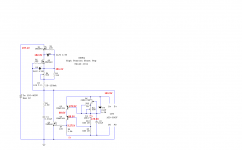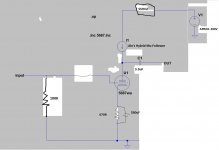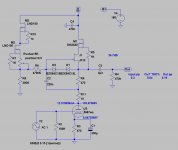I'm very disappointed, (looking for the best SQ I used both devices togheter because both separately the SQ is top notch) the SQ togheter is very bad: cutt off highs & the left the sound only one dimension & lifeless.
I post here to know if other people is in the same situation as me, also asking if there is a technical reason for the bad sound.
I post here to know if other people is in the same situation as me, also asking if there is a technical reason for the bad sound.
It's possible that one makes the other oscillate. You could try adding some resistance (10-22Ω) between SSHV and supply of Ale's module. (IIRC SSHV has a zero implemented in the supply capacitor; this might get defeated by caps on the load side)
Test was done with 100Ω between the SSHV2 & the Ale's module.
Sorry I don't understand: "IIRC SSHV has a zero implemented in the supply capacitor"
Sorry I don't understand: "IIRC SSHV has a zero implemented in the supply capacitor"
It should be OK. You can double check for oscillation by taking an AM radio, and tuning to a weak station. Hold it near the module(s) and check there is no extra interference.
The Zero is a resistor in series with the supply cap, to improve dynamic behaviour.
The Zero is a resistor in series with the supply cap, to improve dynamic behaviour.
SSHV2 has a CCS on its input, and the controlled shunt on output.
R6 (1R8) AND C1 0.33uF is the snubber on output.
Without knowing the whole schematic and voltage/current values, helping is a little difficult. 🙂
Is SSHV2 working without error (with test load) at appropriate voltage and current?
R6 (1R8) AND C1 0.33uF is the snubber on output.
Without knowing the whole schematic and voltage/current values, helping is a little difficult. 🙂
Is SSHV2 working without error (with test load) at appropriate voltage and current?
Hi Felipe
Personally I think is a complete waste of a shunt regulator to be placed in front of the hybrid mu-follower. You have already a very high PSRR with the cascode MOSFET in the gyrator board. No point, at all.
It looks like you may have some oscillation playing around. I notice you have no HT decoupling between the SSHV2 and the input (MOSFET drain) of the gyrator. Bad combination due to the high impedance of the gyrator presented to the SSHV. You may want to try a 100uF cap plus a stacked film 100nF right at the +B and -B connections of the gyrator PCB to see if that's the cause of your audio degradation.
Otherwise hard to follow without sniffing with the right tooling....
Hope this helps
Ale
Personally I think is a complete waste of a shunt regulator to be placed in front of the hybrid mu-follower. You have already a very high PSRR with the cascode MOSFET in the gyrator board. No point, at all.
It looks like you may have some oscillation playing around. I notice you have no HT decoupling between the SSHV2 and the input (MOSFET drain) of the gyrator. Bad combination due to the high impedance of the gyrator presented to the SSHV. You may want to try a 100uF cap plus a stacked film 100nF right at the +B and -B connections of the gyrator PCB to see if that's the cause of your audio degradation.
Otherwise hard to follow without sniffing with the right tooling....
Hope this helps
Ale
Hi Ale,
Once yours hybrid mu-follower warm up the russian teflon cap sounds very very good, no lack of bass like a the beginning. I used also a 100uF + 100R at the B+ without good success because the SQ decreased. Now I'm using only your hybrid mu-follower like for the 26.
Cheers
Felipe
Once yours hybrid mu-follower warm up the russian teflon cap sounds very very good, no lack of bass like a the beginning. I used also a 100uF + 100R at the B+ without good success because the SQ decreased. Now I'm using only your hybrid mu-follower like for the 26.
Cheers
Felipe
1 st. : why did you omitted the grid stopper in preamp?
in gyrator
C1:
R7:
Desired operating point of 5687: Ua, -Vg, Ia
Preamp anode current (voltage on 10R in gyrator, voltage on 470R in preamp):
Anode voltage:
p.s. I agree with Ale. Without SSHV2 the preamp should work.
p.s.2 the 17V margin on SSHV2 CCS is very low.
in gyrator
C1:
R7:
Desired operating point of 5687: Ua, -Vg, Ia
Preamp anode current (voltage on 10R in gyrator, voltage on 470R in preamp):
Anode voltage:
p.s. I agree with Ale. Without SSHV2 the preamp should work.
p.s.2 the 17V margin on SSHV2 CCS is very low.
Hi Ale,
Once yours hybrid mu-follower warm up the russian teflon cap sounds very very good, no lack of bass like a the beginning. I used also a 100uF + 100R at the B+ without good success because the SQ decreased. Now I'm using only your hybrid mu-follower like for the 26.
Cheers
Felipe
Hi Felipe
the gyrator doesn't change with "warm-up" time. It's pretty stable from a tempco point of view. I have not noticed any changes over time am afraid.
Perhaps is something else in your system. I'd also suggest trying without the cathode bypass capacitor, it will sound better in my view....
Cheers
Ale
Ale the Russian teflon caps were new when the lack of bass, now both hybrid mu-followers are sounding with high SQ. The cathode bypass capacitor adds bass so more clear without cap (I tried) thanks.
SSHV2 -> Gyrator works great for me. Overkill, yes.
The voltage drop across your SSHV2 is way too low at 15.6volts. The instructions call for 20v drop across the regulator, but in testing i found it needed more like 35v to work properly while sinking 27ma.
My final implementation has 50v across is, 200v in -> 150v out into the Gyrator for a 01A tube.
The voltage drop across your SSHV2 is way too low at 15.6volts. The instructions call for 20v drop across the regulator, but in testing i found it needed more like 35v to work properly while sinking 27ma.
My final implementation has 50v across is, 200v in -> 150v out into the Gyrator for a 01A tube.
1 st. : why did you omitted the grid stopper in preamp?
Because it uses a small solid copper core wounds
in gyrator
C1: 220nF
R7:470R
Desired operating point of 5687: Ua ~130-140V, -Vg -6V, Ia 12mA
Preamp anode current (voltage on 10R in gyrator 12mA, voltage on 470R in preamp~5-6V):
Anode voltage: ~140-150V
p.s. I agree with Ale. Without SSHV2 the preamp should work.
p.s.2 the 17V margin on SSHV2 CCS is very low.
The SSHV2 CCS is set to 50mA.
Last edited:
Good point and well spotted. The SSHV2 CCS is cascoded and will benefit from +25V for best HF performance.
You have a nice bump at about 2Hz, due to the C2-R6-C1 interaction, so there are the reason of "lifeless".
Try much smaller C2, for example 47nF.
BTW why did you choose the 5687?
It's super driver tube, but in this situation has too much gain (more than 24dB).
Try much smaller C2, for example 47nF.
BTW why did you choose the 5687?
It's super driver tube, but in this situation has too much gain (more than 24dB).
Attachments
R6 Ale's schematic is 10M not 4.7M
Good question: "BTW why did you choose the 5687?"
You have reason Bela have too much gain but sounds very good, isn't a preamp, it's the analog output amp of the noDac, with something half power or less will be good, I have 4P1L but it's really expensive the PSU & the comments about the sound it's not my cup of tea.
Wow output total THD 0.04%
Could you simulate with 0.5VAC of input, thanks?
Good question: "BTW why did you choose the 5687?"
You have reason Bela have too much gain but sounds very good, isn't a preamp, it's the analog output amp of the noDac, with something half power or less will be good, I have 4P1L but it's really expensive the PSU & the comments about the sound it's not my cup of tea.
Wow output total THD 0.04%
Could you simulate with 0.5VAC of input, thanks?
Last edited:
- Home
- Amplifiers
- Tubes / Valves
- Salas SSHV2 + Moglia hybrid mu-follower



